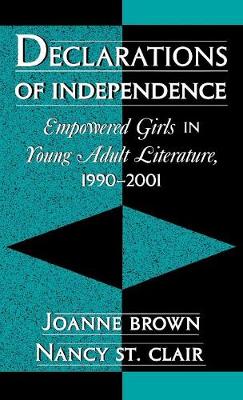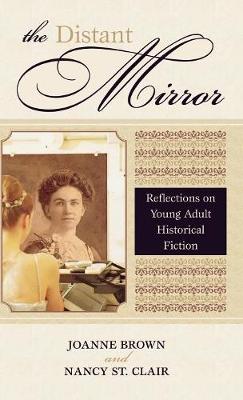Studies in Young Adult Literature
1 primary work • 3 total works
Book 42
Although the United States prides itself as a nation of diversity, the country that boasts of its immigrant past also wrestles with much of its immigrant present. While conflicting attitudes about immigration are debated, newcomers-both legal and otherwise-continue to arrive on American soil. And books about the immigrant experience-aimed at both adults and youth-are published with a fair amount of frequency.
In Immigration Narrative in Young Adult Literature: Crossing Borders, Joanne Brown explores the experiences of adolescents as portrayed in young adult novels. Her study features protagonists from a wide variety of religious and ethnic backgrounds in order to provide a complete discussion of the immigration experience of young adults. In this volume, Brown analyzes young adult novels that portray various aspects of the immigrant experience-journeys to the shores of the United States, the difficulties of adjustment, and the tensions that develop within family units as a result of immigration. Brown also examines how ethnicity, religion, and country of origin affect the adolescent characters' adjustment to their new country, as well as the process of moving from social outsiders to accepted citizens.
This thoroughly researched book includes theories of adolescent development and perspectives on immigration itself applied to the literary analyses. It also offers a framework for anticipating the success of young immigrants and relates this analysis to the novels Brown discusses. With an appendix of additional novels for further reading, this book will be a useful resource for librarians and teachers of adolescent literature, as well as for students, both those born in the United States and those who are immigrants themselves.
In Immigration Narrative in Young Adult Literature: Crossing Borders, Joanne Brown explores the experiences of adolescents as portrayed in young adult novels. Her study features protagonists from a wide variety of religious and ethnic backgrounds in order to provide a complete discussion of the immigration experience of young adults. In this volume, Brown analyzes young adult novels that portray various aspects of the immigrant experience-journeys to the shores of the United States, the difficulties of adjustment, and the tensions that develop within family units as a result of immigration. Brown also examines how ethnicity, religion, and country of origin affect the adolescent characters' adjustment to their new country, as well as the process of moving from social outsiders to accepted citizens.
This thoroughly researched book includes theories of adolescent development and perspectives on immigration itself applied to the literary analyses. It also offers a framework for anticipating the success of young immigrants and relates this analysis to the novels Brown discusses. With an appendix of additional novels for further reading, this book will be a useful resource for librarians and teachers of adolescent literature, as well as for students, both those born in the United States and those who are immigrants themselves.
Female empowerment-especially among girls-is one of the most significant issues to come out of the 90's, and one that will continue to play a significant role in the new millennium. But how do we define empowerment? And more importantly, how do we identify its characteristics within literature? With problems like teenage eating disorders and pregnancy still very much at the core of American society, it is no surprise that a book as important as Declarations of Independence is the latest addition to Scarecrow Press's Studies in Young Adult Literature. Authors Brown and St. Clair use their collective expertise to uncover and trace the development of the young female protagonist from the role of submissive fairy-tale maiden to the spunkier more independent girls who now appear with increasing frequency in young adult literature. This next generation of heroines is the model with which today's readers can readily identify and who the authors believe, become agents of social change for young women. Through careful research that draws on recent scholarship about female adolescent development, situates this shift to stronger female protagonists within a larger cultural context. The empowered girls of this title are defined through close reading of a variety of stories and genres in which they appear-historical and multicultural fiction, social realism, romance and adventure, fantasy, and memoir-with emphasis on books published after 1990. The result is a collection of essays on literature about adolescent girls who have real feelings, passions, and sometimes, rebellious attitudes, and who act upon those feelings, passions, and attitudes to take control of their lives-unlike most of their predecessors, whose fulfillment lay mainly in achieving beauty and suitors. With an annotated list of titles for suggested reading following each chapter Declarations of Independence is the ideal resource for middle and high school teachers, for school and public librarians, a
Young adult historical fiction brings the past alive through stories of adventure, suspense, and mystery. The genre is both complex and controversial, encompassing novels that range from romance and fantasy to stark historical realism. The book examines the various approaches to young adult historical fiction and explores the issues that it has engendered. Part One focuses on the broader issues spawned by the genre itself, including its various subgenres - the line between fiction and fact; to what degree must an author adhere to historical accuracy?; time boundaries; the diary format; the protagonist as the outsider; who is entitled to write what?; and literary concerns such as the relationship between accuracy and readability. Part Two explores issues of contemporary interest, such as race, class, gender, the immigrant experience, religion, war, and nationalism. Thought-provoking discussions of how these elements are treated in historical novels, with emphasis on how current cultural values have shaped the fiction, are presented. Finally, the question of whether novels in this genre are bound by anything other than their respective period setting is posed, and it is contended that there are features common to YA historical novels that not only set the genre apart from other YA fiction, but also contribute something unique to the larger genre. The genesis for much classroom debate, suggestions for class discussions and writing assignments as well as sample written responses of these debates from the authors' classes are included. Teachers, librarians, instructors of young adult literature courses, and teen readers will find this an insightful analysis of YA historical fiction.


